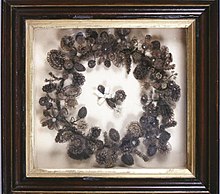Hair image

As hair pictures or hair work refers to images consisting of (mostly human) hair were designed and served as a wall decoration. Most of these objects were created due to a close relationship between the original bearer of the hair and the subsequent owner of the work made from them. In terms of cultural history, hair images are closely related to jewelry made from hair . Both heydays were in the 19th century.
history
Sacrificial cults , popular beliefs , occult rites and votive customs have attached particular importance to human hair for centuries. With the hair of a loved one, you wanted to carry an imperishable part of yourself with you or have it in front of your eyes all the time. This gave rise to the custom of making funeral jewelry or souvenir objects from it. A similar meaning to the pieces of jewelry made from hair that brides and grooms gave each other, had the wall picture-like boxes framed behind glass, with which the memory of special events such as baptism, wedding or death of a loved one in the form of such "secularized relics" (Walter Benjamin) was expressed. It was no coincidence that the art of this hair processing emerged in Romanticism , which cultivated the cult of friendship and feeling and expressed it in the artistic furnishings of the bourgeois living spaces. At the same time, the end of wig fashion around 1800 pushed the hairdressers and wig makers, who now also processed foreign hair, into new fields of activity like this one. Most of the surviving objects date from around 1840 to 1900. After the turn of the 20th century, when lifestyle and handicrafts changed fundamentally, hair work was increasingly considered out of date, the last framed pictures, photos decorated with hair flowers are from the 1930s Years known. The folklore departments of the museums occasionally show a small selection of hair pictures.
Motives and techniques
Basically, two manufacturing techniques can be distinguished: the loop and loop technique and the adhesive technique. Almost all hair pictures contain floral picture elements, which are sometimes associated with motifs such as vases, grave monuments or cornucopia. Bouquets of flowers and flower wreaths are made in the loop and loop technique. For this, the hair was braided , woven or lace , sometimes enriched with small pearls or thin silver or gold wires. The pictures made using the adhesive technique consist of hair cut into small pieces, laid parallel and glued into shapes and are often more figurative than the hair pictures with blossoms and flowers. To protect the fragile, mostly also three-dimensional representations, the hair pictures are framed behind glass throughout. The production was done by hand by wig makers and barbers , and some nunneries also operated the trade. On the other hand, the production was also a pastime for upper-class and noble women. The semi-professional production in rural regions has also been proven.
distribution
Hair work was represented in all of Central and Northern Europe, Southern Europe hardly knew these techniques. The North American examples are likely to be traced back to the influence of Central European immigrant families. So far there is evidence of a hair image from Latin America.
Individual evidence
- ^ Walter Benjamin : Collected Writings , Vol. I, 2, Frankfurt a. M. 1974 p. 681
- ↑ Gockerell, 1980, p. 61
- ↑ Gockerell, 1980, p. 58
- ^ Wittenzellner: hair pictures . 2020, p. 31 ff .
- ^ Wittenzellner: hair pictures . 2020, p. 107 .
Web links
literature
- Nina Gockerell: Jewelry made from human hair. Origins, motivation, development. In: Waffen- und Costumekunde, 1980, pp. 45–64 and 1981, pp. 39–54.
- Alfred A. Peters, Ute Olliges-Wieczorek and Imke Barbara Peters: Jewelry and pictures made from hair - a European cultural heritage. Published for the exhibition "European hair art of the 18th and 19th centuries" at Schloss Britz, Norden 1995.
- Christiane Holm: Intimate braids of memory: memorial jewelry made of hair around 1800. Critical reports, 32nd year, 2004, pp. 29–41.
- Nicole Tiedemann : Hair Art. On the history and meaning of a human piece of jewelry , Cologne 2006.
- Helen Sheumaker: Love entwined. The curios history of hairwork in America , Philadelphia 2007.
- Jana Wittenzellner: Hair pictures. Memories under glass , Berlin 2020.
